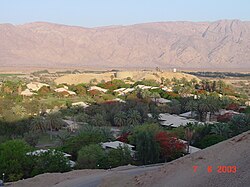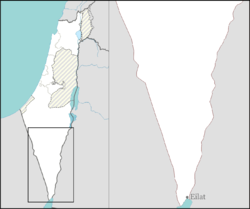Yotvata
|
Yotvata יָטְבָתָה |
|
|---|---|

Yotvata (Edom Mountains in the background).
|
|
| Coordinates: 29°53′44.16″N 35°3′36.35″E / 29.8956000°N 35.0600972°ECoordinates: 29°53′44.16″N 35°3′36.35″E / 29.8956000°N 35.0600972°E | |
| District | Southern |
| Council | Hevel Eilot |
| Affiliation | Kibbutz Movement |
| Founded | 1951 |
| Population (2015) | 657 |
| Website | www.yotvata.org.il |
Yotvata (Hebrew: יָטְבָתָה) is a kibbutz in southern Israel. Located on the Arabah road in the southern Negev, it falls under the jurisdiction of Hevel Eilot Regional Council. In 2015 it had a population of 657.
The Arabah valley is an arid desert where the average annual rainfall is less than 30 mm and temperatures often exceed 40 °C (104 °F) in summer, and 21 °C (70 °F) in winter.
Located approximately 40 km north of the Red Sea, Yotvata is the first, biggest, and most prosperous Kibbutz in Hevel Eilot Regional Council. Being relatively far from major urban centers (41 kilometers north of Eilat and 130 kilometers south of Dimona), it is the center of the region, where most regional facilities are based: regional school, regional council offices, community center, sports center, movies and concerts hall and local airfield.
Yotvata started in 1951 as a Nahal settlement named Ein Radian. In 1957 it was established as the first kibbutz in the southern Arabah region by Ihud HaKvutzot VeHaKibbutzim. The kibbutz is named after an Israelite encampment mentioned in Numbers 33:34 and Deuteronomy 10:7: "…from there they went to Gudgodah, and then to Jotbatha, a land of streaming water." Althme debates over the exact location of the biblical Yotvata (some say that it is closer to the Red Sea near Taba), the idea of a desert oasis for Israelis was in the founders' mind; the local oasis was the Ein Radian wellspring.
The founders, a small group of men and women 20 years of age and just out of the military service, decided to pursue a life of pioneering and built their home in the desert. They had massive challenges presented by the desert: the burning sun, the heat, shortage of water, salty land and water, limited transportation and no secure source of income. They started making all kinds of agricultural trials growing grapes, pomegranates and vegetables; they raised cattle and chickens - all with little success. The dates plantation proved more suitable to the arid conditions.
...
Wikipedia

